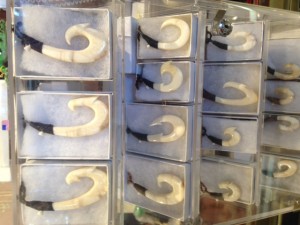A long time ago, the days were very short because the sun, Kalā, raced across the sky as he pleased. There were just a few hours of daylight before the lazy moon crept slowly across the darkness. There was only a little day and a very long night. At that time of the short days and long dark nights, there was a beautiful woman named Hina who lived on the island of Hawaii in a cave behind Rainbow falls. Hina was known for the fine kapa cloth she made from the bark of wauke and māmaki trees. Hina’s handiwork was prized in the community for making kihei, malo for the men, and a’u for the women. But because Kala raced through the sky, refusing to share his light and warmth, Hina didn’t have enough time in the day to dry her kapa. Now, the sun’s behavior wasn’t just a problem for Hina; fishermen didn’t have enough time in the day to catch enough to feed their families, farmers’ crops couldn’t grow without sunlight, and fruit wouldn’t ripen on the trees. Everyone was suffering. Hina had four sons, and the youngest was named Māui. He was a clever boy, quick and strong. Hina knew her youngest child was special, but Māui was only beginning to suspect he was capable of many wondrous things…
After so much time watching his mother struggle with her work and run out of time to dry her beautiful kapa, Māui decided he would be the one to capture Kalā and make him promise to slow down…
Māui started up the rough and steep slopes of the great mountain Haleakalā. It was a long, cold, and difficult journey. He was weary, and doubt slowly started creeping into his mind. Many times he thought about turning back and leaving things the way they were. But the thought of his mother and her hard work pushed him through the night and he realized that there was no journey back. He had to make things pono. He had to confront the mighty Kalā…
When he finally reached the summit of Haleakalā, Maui battled Kalā for his attention and with his special coconut fiber rope and stone adze from his mother, he snared Kalā and forced him to listen…
Māui and Kalā had a long talk about community and responsibility and the great honor in doing one’s work properly…
They agreed that during the summertime Kalā would travel more slowly across the sky to help the people of the world but that he could make his daily journey faster during the winter months so that he, and everyone else, could have more sleep. Kala kept his promise. Soon, crops were flourishing as they never had before. People had enough daylight hours to do their work and everyone enjoyed health and abundance; a great relief after all that suffering. Hina was finally able to dry her kapa properly, which meant that the cloth was even more refined and able to hold rich colors and intricate patterns. She made Māui special kapa clothing, the most beautiful that anyone had ever seen in all of Hawaii. Māui had many other great adventures, but this was probably his bravest deed—especially since he was a young man at the time. Māui distinguished himself as a great hero and a brave man by helping his mother with her laundry. But you see, everyone has responsibilities; Kalā’s kuleana was to bring light and warmth to all living things so the world could grow and thrive. He quickly learned to care about every plant and animal and person in the world. Because of this he became quite proud of his work and did it the best he could. He did it with honor and aloha.
How did you come across this folklore: “through research, these are favorite legends from my collection because I collect and shares mo`olelo/stories from the Hawaiian islands.”Other information: “These are well known folk tales/legends passed down from generations and written in the Hawaiian newspapers and several collections.”This story is often referred to as one of the “legends of Māui,” but this should be considered as more of a folk tale for its format and truth value relationship to people in the islands. It can also be considered as fitting into the myth genre, because it is using these kinds of characters and tales to explain the workings of the world (for example, the deal between Māui and Kalā aligning with/explaining the seasons). And the story is used to dictate behavior; people aspire to be brave, strong, heroic, and selfless like Māui, regardless of the truth/reality of the story itself.
For another version of this, see the book, Maui, How It Came to Be.
Kyselka, Will, and Ray E. Lanterman. Maui, How It Came to Be. Honolulu: University of Hawaii, 1980. Print.

